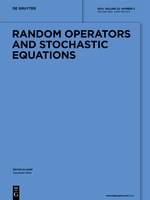
Random Operators and Stochastic Equations
Scope & Guideline
Connecting Scholars in Stochastic Studies
Introduction
Aims and Scopes
- Stochastic Differential Equations (SDEs):
The journal emphasizes the study of stochastic differential equations, including their existence, uniqueness, stability, and control aspects, often driven by various types of noise such as fractional Brownian motion and Lévy processes. - Optimal Control Theory:
Optimal control problems, especially those involving stochastic systems, are a core focus. The journal publishes work on maximum principles, control strategies, and applications to real-world problems. - Random Processes and Their Applications:
Research on random processes, including their mathematical properties and applications in fields such as finance, physics, and engineering, forms a significant part of the journal's scope. - Fractional Calculus and Differential Equations:
The journal features studies on fractional calculus, particularly in the context of stochastic differential equations and their applications, highlighting the growing interest in non-integer order derivatives. - Existence and Uniqueness Results:
A consistent focus on establishing existence and uniqueness results for various types of stochastic equations and systems is evident, contributing to the theoretical foundation of the field. - Advanced Mathematical Methods:
The journal publishes innovative mathematical techniques and methodologies, including new approaches to solving stochastic equations and analyzing stochastic systems.
Trending and Emerging
- Fractional Stochastic Calculus:
There is a notable increase in the exploration of fractional calculus within stochastic contexts, indicating a growing interest in non-local effects and their implications in stochastic modeling. - Stochastic Control with Regime Switching:
The emergence of studies focusing on stochastic control problems under regime-switching settings reflects the need for sophisticated modeling in dynamic environments, particularly in finance and economics. - Advanced Numerical Methods for Stochastic Equations:
Recent papers are increasingly focusing on the development and analysis of numerical methods for solving stochastic differential equations, highlighting the practical importance of computational approaches. - Stochastic Systems with Jumps:
Research on stochastic systems that incorporate jump processes is on the rise, showcasing the relevance of modeling abrupt changes in various applications, including finance and insurance. - Applications in Financial Mathematics:
The journal is seeing a trend towards applications of stochastic theory in finance, particularly in portfolio optimization and risk management, reflecting the industry's demand for quantitative approaches.
Declining or Waning
- Classical Stochastic Processes:
Traditional stochastic processes, such as simple random walks or basic Markov chains, seem to be receiving less attention compared to more complex stochastic systems and advanced methodologies. - Deterministic Control Systems:
Research focusing solely on deterministic control systems without stochastic elements has declined, as there is a shift towards integrating randomness in control theory. - Basic Statistical Methods:
The journal has seen a reduction in the publication of papers focused on basic statistical methods and techniques, with an increasing preference for more complex and advanced statistical models and methodologies.
Similar Journals

Applied Mathematics Letters
Showcasing Influential Research for a Mathematical TomorrowApplied Mathematics Letters is a prestigious journal dedicated to the dissemination of significant research in the field of applied mathematics. Published by PERGAMON-ELSEVIER SCIENCE LTD in the United Kingdom, this journal serves as a vital resource for researchers, professionals, and students alike, aiming to bridge theoretical findings and practical applications. With an impressive impact factor placing it in the Q1 category and ranked 33 out of 635 in the Applied Mathematics category by Scopus, it showcases influential articles that contribute to advancements across various applications of mathematics. The journal's coverage from 1988 to 2025 ensures a rich archive of research that remains relevant and insightful for contemporary studies. Currently, it operates under a subscription-based model, providing access to cutting-edge research that forms the backbone of mathematical application in science and engineering. To become part of this dynamic community of scholars, readers are encouraged to explore the latest findings and ongoing discussions that highlight the interplay between mathematics and its real-world impacts.

ESAIM-CONTROL OPTIMISATION AND CALCULUS OF VARIATIONS
Elevating Knowledge in Control Theory and VariationsESAIM: Control, Optimisation and Calculus of Variations is a prestigious academic journal, published by EDP Sciences S.A., that plays a crucial role in disseminating high-quality research in the fields of computational mathematics, control theory, and optimization. Established in 1996 and running until 2024, this journal is recognized for its significant impact, boasting a distinguished Q1 classification in multiple relevant categories as of 2023. With its rigorous peer-review process and commitment to advancing knowledge, it serves as an essential resource for researchers, professionals, and students seeking in-depth studies and innovative methodologies in the mathematical and engineering sciences. Although it operates under traditional access options, the journal’s reputation and ranking—positioned among the top percentile in various Scopus categories—underscore its importance for those engaged in cutting-edge research and practical applications in control and optimization paradigms.

JOURNAL OF THEORETICAL PROBABILITY
Pioneering Research for Tomorrow's Mathematical ChallengesThe Journal of Theoretical Probability is a prominent academic journal dedicated to the dissemination of cutting-edge research in the fields of probability theory and its applications. Published by Springer/Plenum Publishers, this journal has established itself as a vital resource for researchers and professionals interested in theoretical advancements and practical implementations within the realm of mathematics, particularly in the categories of Statistics and Probability. With an impressive converged publication trajectory from 1988 to 2024, the journal holds a commendable Q2 quartile ranking across various disciplines including Mathematics and Statistics and Probability as indicated in the 2023 metrics. Although not Open Access, the journal continues to attract high-quality submissions that contribute significantly to the field, making it an essential platform for advancing theoretical understanding and fostering academic dialogue. Whether you are a seasoned researcher or a graduate student, the Journal of Theoretical Probability offers valuable insights and rigorous scholarship that can enhance your academic pursuits.
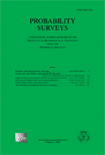
Probability Surveys
Exploring the Intersection of Theory and Application in Statistical Science.Probability Surveys is a premier open-access journal dedicated to the advancement of knowledge in the fields of Statistics and Probability. Published by PROBABILITY SURVEYS, this esteemed platform has been curating high-quality surveys and reviews since its inception in 2004. With an impressive impact factor and recognition as a Q1 journal in its category, it ranks an admirable #32 out of 278 in its Scopus category, placing it in the 88th percentile among its peers. As a scholar-focused resource, it strives to bridge the gap between mathematical theory and practical application, providing insights valuable to researchers, academicians, and industry professionals alike. Located in the United States with contributions from esteemed names in the field, Probability Surveys supports enhanced accessibility to important research through its open-access model, ensuring that cutting-edge findings are available to a broad audience. Whether you are a seasoned researcher or a student embarking on your journey in statistical disciplines, this journal serves as an indispensable reference point on the state-of-the-art developments in probability.
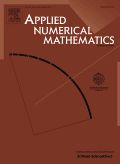
Applied Numerical Mathematics
Exploring New Horizons in Applied Mathematics.Applied Numerical Mathematics is a prestigious journal published by Elsevier, focused on advancing the field of numerical analysis through rigorous research and innovative methodologies. With an impressive impact factor and a solid reputation, this journal occupies a leading position in the academic community, as evidenced by its Q1 rankings in Applied Mathematics, Computational Mathematics, and Numerical Analysis for 2023. This status makes it an essential resource for researchers and professionals eager to stay at the forefront of numerical techniques and applications. Covering a broad range of topics from algorithms to theoretical developments, the journal invites submissions that contribute to the theoretical and practical advancements in numerical methods. Its convergence over the years, beginning in 1985 and extending through 2025, signifies its enduring relevance and commitment to addressing contemporary scientific challenges. Despite its traditional publication model, researchers can access the journal's rich content through various institutional subscriptions, facilitating the dissemination of knowledge across the globe.

Journal of Analysis
Connecting Researchers Through Mathematical DiscourseThe Journal of Analysis, published by SPRINGERNATURE, serves as a crucial platform for disseminating advanced research in the fields of mathematics, particularly focusing on Algebra, Number Theory, Analysis, Applied Mathematics, Geometry, Topology, and Numerical Analysis. Since its inception in 2016, this journal has aimed to foster knowledge-sharing and innovation among researchers, professionals, and students. Boasting a diverse scope and a commitment to high-quality research, the journal is indexed in various categories with rankings that reflect its growing influence, particularly in Algebra and Number Theory (Q4), Analysis (Q3), and Applied Mathematics (Q3), among others. With an ISSN of 0971-3611 and E-ISSN of 2367-2501, it offers insightful articles that contribute to the ongoing discourse in mathematics. The journal is located in Germany, ensuring a European perspective while also welcoming global contributions. Researchers seeking to enhance their understanding and impact in their respective fields will find this journal an invaluable resource.
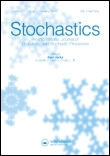
Stochastics-An International Journal of Probability and Stochastic Processes
Advancing Knowledge in Modeling and SimulationStochastics: An International Journal of Probability and Stochastic Processes, published by Taylor & Francis Ltd, is a pivotal platform for the dissemination of innovative research in the realms of probability and stochastic processes. Since its inception in 1975, the journal has evolved to encapsulate a rich array of methodologies and applications, contributing significantly to the fields of modeling, simulation, and statistical analysis. With a current impact factor ranking in the Q3 category for both Modeling and Simulation and Statistics and Probability, it positions itself as a valuable resource for professionals, researchers, and students alike. The journal’s coverage spans a unique historical arc from 1975, and it continues to push boundaries up to 2024, ensuring the latest trends and discoveries are accessible to an engaged audience. Though not Open Access, the journal’s scholarly contributions are crucial for advancing understanding and innovation in stochastic modeling, making it an essential read for those seeking to deepen their expertise in the field.

SIAM JOURNAL ON CONTROL AND OPTIMIZATION
Empowering Researchers with Cutting-edge Optimization TechniquesSIAM Journal on Control and Optimization, published by SIAM Publications, is a premier academic journal dedicated to advancing the study and application of control theory and optimization techniques. Since its inception in 1969, this journal has provided a platform for groundbreaking research within the fields of applied mathematics, control systems, and optimization methodologies, ranking in the top quartile (Q1) in both disciplines as of 2023. With an impressive Scopus ranking of #139 in Applied Mathematics and #34 in Control and Optimization, it attracts high-quality submissions and reaches a broad audience of researchers, professionals, and students. The journal offers a mix of theoretical and practical insights, making it an essential resource for anyone looking to stay abreast of the latest developments in these rapidly evolving fields. With no open access option currently available, the journal ensures that the rigor and depth of its content are made available to educational institutions and organizations committed to academic excellence.
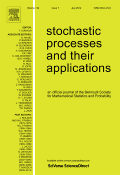
STOCHASTIC PROCESSES AND THEIR APPLICATIONS
Elevating Research in Probability and ModelingSTOCHASTIC PROCESSES AND THEIR APPLICATIONS, published by Elsevier, is a leading journal in the realms of Applied Mathematics, Modeling and Simulation, and Statistics and Probability. Established in 1973 and continually evolving with the latest research trends, this journal has secured its place in the Q1 category across multiple disciplines, reflecting its influence and prestige in the academic community. With a Scopus Rank of #90 in Statistics and Probability and notable rankings in Applied Mathematics and Modeling and Simulation, it serves as a crucial platform for disseminating cutting-edge research findings and applications of stochastic processes. Although it operates under a traditional access model, its comprehensive scope encourages submissions from a diverse range of topics that push the boundaries of knowledge in probability theory and its practical applications. Researchers, professionals, and students are invited to contribute original research, reviews, and case studies that can propel the field into new territories, further solidifying the journal's role as an essential resource for advancing understanding in stochastic processes.
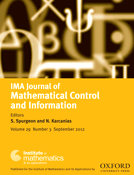
IMA JOURNAL OF MATHEMATICAL CONTROL AND INFORMATION
Exploring Innovative Solutions in Control and Optimization.IMA Journal of Mathematical Control and Information, published by Oxford University Press, is a prestigious journal dedicated to advancing the fields of mathematical control, optimization, and information theory. Since its inception in 1984, it has been a vital resource for researchers and professionals, providing a platform for high-quality scholarly articles that explore innovative methodologies and theoretical advancements. With an impressive Q2 ranking in categories such as Applied Mathematics and Control Systems Engineering, the journal is recognized for its rigorous peer-review process and significant contributions to mathematics and engineering. While it does not currently offer Open Access options, its impact is reflected in its notable Scopus rankings, including a rank of #47 in Control and Optimization. As it continues to converge into 2024, the IMA Journal remains a cornerstone for academics and practitioners seeking to deepen their understanding and application of mathematical concepts in control and information systems.